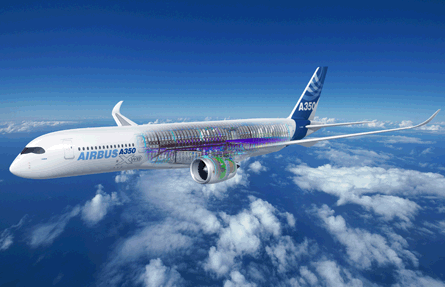Airbus's A350 programme manager estimates the A350-1000 will retain 70% commonality with the smaller A350-800/900 after changes have been made to the large twinjet to improve payload and range.
But Didier Evrard believes customers will accept the divergence when weighed against the benefits of the aircraft, even though the main change - a higher-thrust Rolls-Royce Trent XWB powerplant - will postpone entry into service by two years, to mid-2017.
Evrard told Flight International that customers "all understood" the decision to adapt the aircraft.
An upgrade to the Trent will provide a thrust increase to 97,000lb (431kN) from the previous level of 93,000lb. The A350-1000 will gain 400nm (740km) range with 350 passengers or another 4.5 tonnes in payload. The A350-1000's maximum take-off weight will increase from 298 tonnes to 308 tonnes, and its list price will rise by $9 million as a result of the changes.
 |
|---|
© Airbus |
Rolls-Royce is also to become the exclusive engine supplier on the -1000. The Trent XWB engine to power the -1000 will incorporate benefits derived from the manufacturer's Advance 3 technology demonstrator programmes.
The manufacturer will not increase the fan size, but will spin it 6% faster and alter the internal aerodynamics - shaping the inner annulus at the hub - to draw a larger airflow through the same intake.
It is scaling up the core with an annulus which is 3-4% larger. Among the efficiency measures are a dual microstructure technique implemented in turbine manufacture that enables the properties of the engine discs to differ in line with the differing temperatures at the hub compared with the rim.
The empty weight of the aircraft will increase by 2.4 tonnes, of which each engine will contribute 250kg (550lb), although Rolls-Royce is planning a weight-reduction programme in the fan.
It will optimise the configuration of the engine by mid-2012 and plans the first higher-thrust XWB engine run in mid-2014 for first flight in early 2016. Some of the technology will be implemented on other Trent engines.
Civil aerospace division president Mark King said that the company knew from early testing of the powerplant that it could offer an improved version. The XWB engine was beating targets for internal aerodynamic efficiency, specific fuel consumption and generating cooler turbine temperatures.
"Having seen demand from customers, having seen what's happened on testbed, we [thought we had] other options," he said. "When we saw what this aircraft could do with an engine like that, we had no hesitation."
King said the manufacturer had the capability to build a larger core to increase thrust to 97,000lb with the same fan diameter and without an impact on fuel burn.
Airbus is retaining the same fuselage size on the twinjet: a five-frame stretch aft of the wing and a six-frame stretch forward, compared with the A350-900. Externally, the aircraft will appear little different from its previous iteration.
Evrard said the pylon would be reinforced to accommodate the larger XWB engine but would stay the same size. Although the engine has a larger core, the aerodynamic lines of the nacelle will be "unchanged".
He said the trailing-edge extension on the wing, which will be around 300mm (11.8in) compared with the A350-900, has also been optimised. "We had to look at the positioning of the [flap] actuators," he said. "It's slightly different from the -900, but good from an aerodynamic point of view."
Air conditioning will need to be expanded in the larger -1000, he added, but "this was foreseen".
"We believe commonality on the [-1000] aircraft will be 70% still," said Evrard. "Airlines are certainly interested in this increased capability of the aircraft, the increased thrust. All the airlines I've talked to have underlined this."
Evrard said there were no problems of concern with the composite manufacturing process. "We've made all the panels for the first aircraft, even beyond that. We're very pleased with that."
He pointed out that the panel design concept enables the airframer to "balance tolerances on both sides" of the fuselage. "The indication is that it seems to be going quite well, but I'll be more confident when we've assembled the panels and made the barrel," he said.
Along with barrel manufacture, Airbus is also preparing to deal with managing the supply-chain production of thousands of smaller components. "This is the challenge we have," Evrard said, admitting that the individual suppliers are "not at the same level".
He added: "Some need a bit more coaching, more development," although he declined to identify specific suppliers.
Airbus is also planning a weight-reduction scheme for the A350-900, the first member of the family, said A350 chief engineer Gordon McConnell.
"We want to get back to a weight that's consistent with what we said we'd deliver to airlines," he said, although he would not disclose further details of the package beyond stating that it amounted to an "optimisation of the design we have".
Airbus chief operating officer Fabrice Bregier claimed the A350-1000 would retain "close to 100% hardware commonality" with the A350-900, planned for service entry by the end of 2013.
- All the latest news, images and video from the 2011 Paris air show
Source: Flight International
















